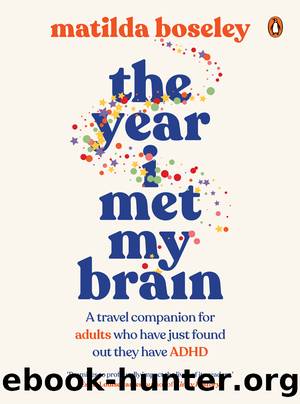The Year I Met My Brain by Matilda Boseley

Author:Matilda Boseley [Boseley, Matilda]
Language: eng
Format: epub
ISBN: 9781760146467
Publisher: Penguin Random House Australia
Obviously, plenty of our sleep issues are caused by simply not having the executive-functioning capacity to get ourselves to bed on time, or not being able to quiet our brains, but this might not be the whole story. In Chapter 4, I mentioned that a decent whack of ADHDers potentially have issues with a delayed circadian rhythm,21 meaning the simple comfort of âbeing sleepy when itâs bedtimeâ isnât guaranteed. But there are potentially some fixes for that as well.
One fairly popular and reasonably effective option22, 23 is to take melatonin supplements (but please talk to your doctor first, especially if youâre already on ADHD medication, because when used incorrectly or for too long, melatonin has been linked to depression). Iâve found melatonin incredibly helpful. Itâs not a miracle fix, and Iâll still have nights staring at the ceiling on occasion, but itâs really great for speeding up that eyes-heavy, mind-empty, acute feeling of tiredness when I need to rip myself away from my phone and put effort into going to sleep.
If melatonin isnât for you, thereâs another (admittedly less robustly researched) tactic, thatâs either very funny or extremely Black Mirrorâesque, depending on how you see it. Itâs buying a sunrise online. Hear me out.
Basically, one way to potentially get our circadian rhythm and our melatonin-release schedule back on track is to beat our brains over the head with the fact that the sun is up by using something called âmorning bright-light therapyâ. For half an hour first thing each morning, you chill out with your face 60 centimetres away from a super-bright (at least 10,000 lux) lamp usually used for seasonal affective disorder. Two studies on ADHDers showed a significant improvement, both in bringing their circadian rhythm forward and reducing ADHD symptoms in general, for the weeks they used bright-light therapy.24, 25 But while the results were promising, the study sample sizes were small, so thereâs no guarantee it will be worth the cash splash.
I believe part of the morning-light therapy process is meant to include limiting your exposure to blue light at night, too, meaning no screens or phone in bed. But given my brainâs night-time tendency to become consumed with the crushing reality that I will one day die when itâs not constantly distracted by technology, I went for the alternative technique suggested by one study, which is wearing blue-light-blocking glasses from 4 pm onwards.26 I ran my own extremely small science experiment on these two tactics for a few weeks and my conclusion was . . . yeah, sure, I think it helped a bit. But, god, itâs hard to remember to put on those glasses at 4 pm.
So, those are the four main pillars of reducing the intensity of our ADHD impairments. Achieving this lifestyle is still a difficult (potentially lifelong) mission, but hopefully, even with little, incremental improvements, we will start giving our Ethel some room to breathe. Sheâs earned it.
Now weâve gone through all the ways we can help our brain fit our world, itâs time to talk about how we can make our world fit our brain.
Download
This site does not store any files on its server. We only index and link to content provided by other sites. Please contact the content providers to delete copyright contents if any and email us, we'll remove relevant links or contents immediately.
Hit Refresh by Satya Nadella(8344)
When Breath Becomes Air by Paul Kalanithi(7273)
The Girl Without a Voice by Casey Watson(7271)
Do No Harm Stories of Life, Death and Brain Surgery by Henry Marsh(6342)
A Court of Wings and Ruin by Sarah J. Maas(6110)
Hunger by Roxane Gay(4232)
Shoe Dog by Phil Knight(4181)
Everything Happens for a Reason by Kate Bowler(4075)
A Higher Loyalty: Truth, Lies, and Leadership by James Comey(4039)
The Rules Do Not Apply by Ariel Levy(3913)
Tuesdays with Morrie by Mitch Albom(3839)
The Immortal Life of Henrietta Lacks by Rebecca Skloot(3833)
How to Change Your Mind by Michael Pollan(3686)
Millionaire: The Philanderer, Gambler, and Duelist Who Invented Modern Finance by Janet Gleeson(3575)
All Creatures Great and Small by James Herriot(3526)
Elon Musk by Ashlee Vance(3460)
Tokyo Vice: An American Reporter on the Police Beat in Japan by Jake Adelstein(3441)
Man and His Symbols by Carl Gustav Jung(3325)
The Money Culture by Michael Lewis(3291)
